Set them together and their subtle differences emerge.

| Type | Three tin-lined Windsors with iron handles attached with three copper rivets | ||
| French description | Trois sauteuses évasées étamées avec queue de fer munie de trois rivets en cuivre | ||
| Dimensions | 26.5cm diameter by 9.5cm tall (10½ by 3¾ inches) | 26.5cm diameter by 11.5cm tall (10½ by 4½ inches) | 24.5cm diameter by 8.8cm tall (9½ by 3½ inches) |
| Thickness | Almost 3mm at rim | Likely 3mm by weight | Likely 2-2.2mm by weight |
| Weight | 3410g (7.52 lbs) | 3548g (7.82 lbs) | 2736g (6.03 lbs) |
| Stampings | “Lamalle New-York City Made in France” |
“Barthère Bordeaux”; “D” | “Williams Sonoma France” and “Villedieu France” |
| Maker and age estimate | Lefèvre Frères or Mauviel; Between 1957 and 1992 | Unknown maker; 1920s-1940s (estimated) | Mauviel for Williams Sonoma; 1990s |
| Source | eBay | eBay | Craigslist |
| Owner | Bryan P. | ||
VFC says: This post was written and photographed by reader and collector Bryan P.
Lamalle
The Lamalle Windsor was acquired as part of a set on eBay. This Windsor is closer to 3mm at the rim, which seems consistent with the quality of copper that Mr. Lamalle sold. Based on its condition in the pictures, I had the set sent to Rocky Mountain Retinning, and Erik and his team did a great job with all four pieces.
The rivets are machine-made and unfortunately the numbers are no longer recognizable. The rivets have a concentric circle mark. The handle is smooth with slight file marks along the neck, and there is a seam on the inside of the hanging loop indicating that the handle was cast.


 It has the three-line version of the Lamalle stamp and a separate “Made in France” stamp. Based on a NY Times article, “Mr. Lamalle’s major suppliers of copperware are Mauviel, Havard and Lefèvre.” The pan does not have the hammered bottom and smooth sides of a Havard pan.
It has the three-line version of the Lamalle stamp and a separate “Made in France” stamp. Based on a NY Times article, “Mr. Lamalle’s major suppliers of copperware are Mauviel, Havard and Lefèvre.” The pan does not have the hammered bottom and smooth sides of a Havard pan.
Assuming the Windsor and its companion pieces were purchased at similar times, the stamp on the sister Dehillerin pans dates the Lamalle from around 1957 forward.
VFC says: It’s a toss-up for me whether this piece is Lefèvre Frères or Mauviel. At first I thought that it was Lefèvre, but its handle is almost identical to the Mauviel-made Williams Sonoma pan you will see below.
One factor that suggests it is not Mauviel is its smooth finish. In my experience, Mauviel always hammered its thick tin-lined machine-pressed pans to work-harden them, while thinner table-service pans that weren’t intended for stovetop service didn’t need the work-hardening and so retained their mirror finish.
But the trouble with French copper is that there are exceptions to every rule. Mr. Lamalle opened his store in 1927 and was one of the earliest importers of French copper. Perhaps as a long-term customer, he could request a special production run from Mauviel (or Lefèvre, for that matter): extra-thick iron-handled copper pieces with a mirror polish. Sure, they may not prove to be as dent-resistant as as work-hardened piece, but perhaps Mr. Lamalle knew that the average home cook in the US would not subject her copper to the same abuse as it would see in a restaurant kitchen. And it is beautiful — much as I admire the facets of hammered pieces, I have to admit this pan is a real standout.
Barthère Bordeaux
The Barthère Bordeaux Windsor was purchased on eBay. Of the three, this is the largest in both size and weight. It’s also the oddball of the group. While it’s a full 2mm thick, it’s slightly handle heavy, which actually makes it easier to pick up by the end of the handle (when empty) compared to the other two pans. The center of balance is closer to the where the handle base and the pan meet. Of the three, I’d guess it’s the oldest and has seen time in a commercial kitchen.
The surface is hammered, but it looks like the lip to the right on the handle was hammered or rehammered more recently. Other than the (what appears to be) newer hammering around the lip, the pan is hammered on the sides and bottom. The handle has light file marks around the throat, while the hanging loop is free of burrs.
The rivets seem to fall into the machine made, in hand riveted handles category. The handle is cast, with some pock marks or voids from the mold and file marks along the throat. An attempt to retin it was made at some point, but the tin job is splotchy and needs to be redone before its used.

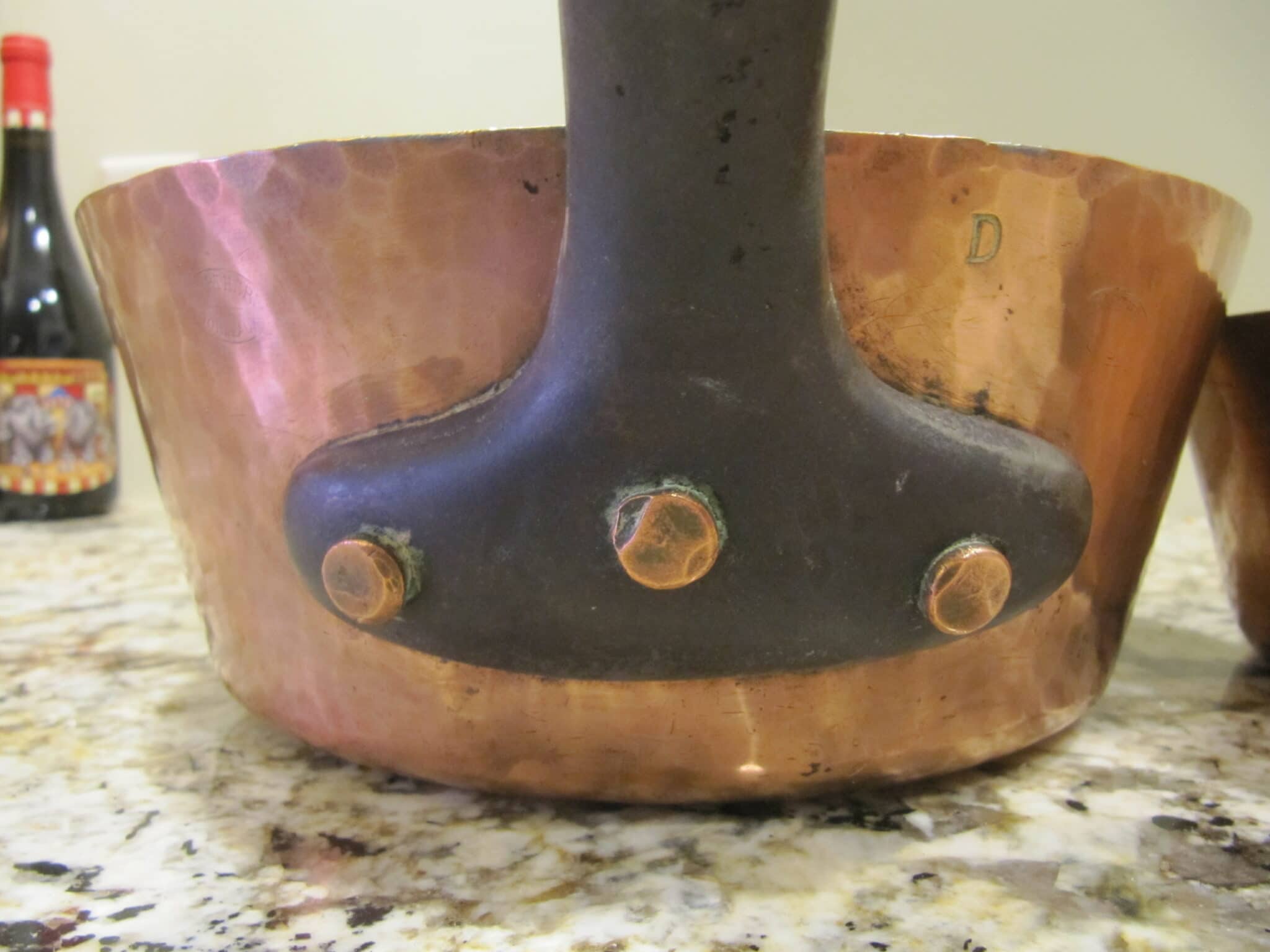
I’m having a hard time determining who made the pan and its age. It’s double stamped “Barthère Bordeaux” with a separate single stamp of “D”. The “D” stamp seems to be older and deeper struck, while the two Barthère Bordeaux stamps are shallow and faded.



VFC says: Thanks to some investigative work by Martin, we were able to identify this mark as the store stamp for a quincaillerie-ferronnerie (hardware store and ironmonger) at 1 Cours Saint-Louis in Bordeaux. The earliest owner I can find is G. Malacrida in 1895; by 1908, it was E. Barthère successeur. In 1925, it was quincaillerie-mènage (hardware and kitchenware) P. Barthère fils, lasting until at least 1944; by the 1950s it was Maison Barthère, fournitures générales hotelières, with three locations in Bordeaux. The last record I can find for the business is in 1962. These records are all indirect — postcards and commercial invoices that have survived — and I have no business records as to its formation and changes in ownership.
But still, thanks to Martin, we have some idea of this pan’s history! I would bet that it was sold by P. Barthère sometime in the 1920s to 1940s. It looks like a pre-WWII pan to me, and the practice of stamping owner’s marks onto copper had dwindled by that time. Also, whereas E. Barthère was a hardware store and ironmonger, P. Barthère described itself as a hardware and kitchenware store that would be more likely to sell copper pans. I’ll keep an eye out for better records — Bordeaux is not as thoroughly documented as Paris — and if anyone can contribute more information, it would be welcome!
Williams Sonoma
The Williams Sonoma Windsor was acquired through Craigslist and the seller had never used it. He’d purchased it at an estate sale and it had languished in storage for about a year. It’s a solid 2mm+ at the rim (no calipers).
The handle is roughly finished with visible file marks and the hanging loop has burrs left over from the casting process. There’s a small amount of copper showing through on two of the rivets, while the rest of the tin lining is in good usable shape. One of the rivets is stamped “16”, while presumptively the number has worn away from the other two.


 Its most interesting characteristic is the companion stamp. Rather than the slightly rounded Mauviel “Made in France” stamp, this has the two-line “Villedieu France” stamp. I still think it’s a Mauviel made pan based on VFC’s “Michel Lejeune Asnières” article, which seems to place production of the pan to 1973 or later. Not surprising since I suspect that the tin is original.
Its most interesting characteristic is the companion stamp. Rather than the slightly rounded Mauviel “Made in France” stamp, this has the two-line “Villedieu France” stamp. I still think it’s a Mauviel made pan based on VFC’s “Michel Lejeune Asnières” article, which seems to place production of the pan to 1973 or later. Not surprising since I suspect that the tin is original.
It does beg the question, since most of the cookware imported into the US with a store stamp (Bazaar de la Cuisine, Bazar Français, BonJour, The Bridge Company, Sur La Table, etc.) seems to be produced by Mauviel, is there a difference between those pans stamped “Made in France” vs “Villedieu France”?
VFC says: I think “Villedieu France” is a Mauviel mark and I’m trying to place it among the existing Mauviel stamps with which I am familiar. There is an oval “Mauviel Villedieu” stamp (alongside “Made in France”) that I think was used from 1962 to 1985, perhaps for copper sold directly from the Mauviel factory store; I think copper for Williams Sonoma or Dehillerin got their store stamps (alongside “Made in France”) instead. (After 1985, I believe Mauviel began using the italic-e “Mauviel Made in France” stamp.) I suspect this “Villedieu France” mark was also used from 1962 to 1985, but I don’t know under what circumstances. Was it an alternative version of “Made in France”? Under what circumstances was it used? I have a few pans with this stamp and I’ll pull them out and take a look and see what they have in common.
Take a look at all three of them below — left to right, Lamalle, Barthèrz Bordeaux, and Williams Sonoma.

And here are the handles. Set in a different order — left to right, Barthèrz Bordeaux, Williams Sonoma, and Lamalle — you can see how dissimilar the Bartherz pan is from the other two: it’s taller, and the handle is also mounted lower on the sidewall. I think the Williams Sonoma and Lamalle pans are both post-WWII pieces, when there were fewer French chaudronneries and the design of the pans settled into the proportions we recognize today.

I’d like to thank Bryan for bringing these pans together so we can see them. It’s only by setting pieces from different makers and eras together that we can start to discern the subtle differences between them and unpack the methods and styling of their makers.
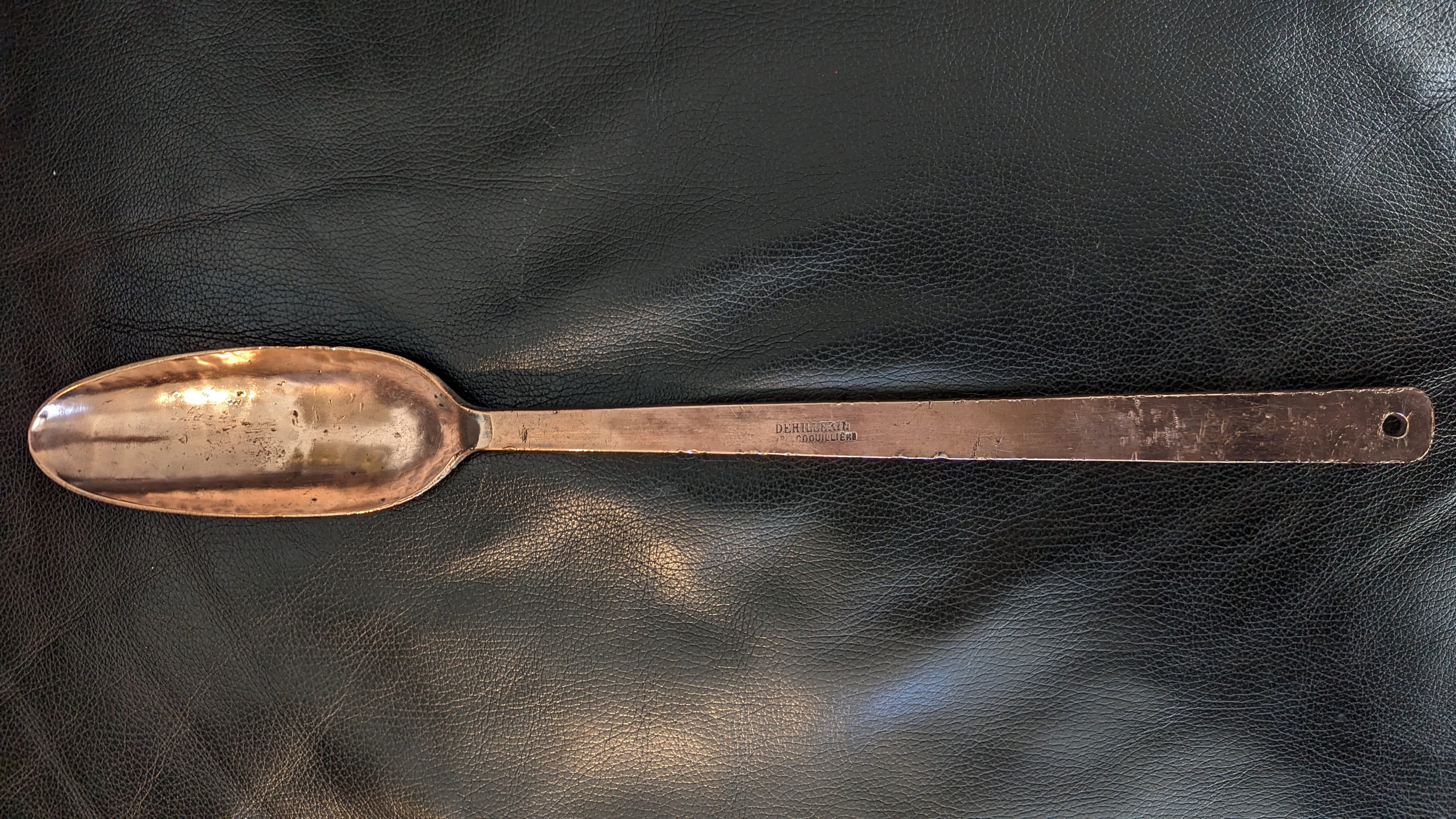

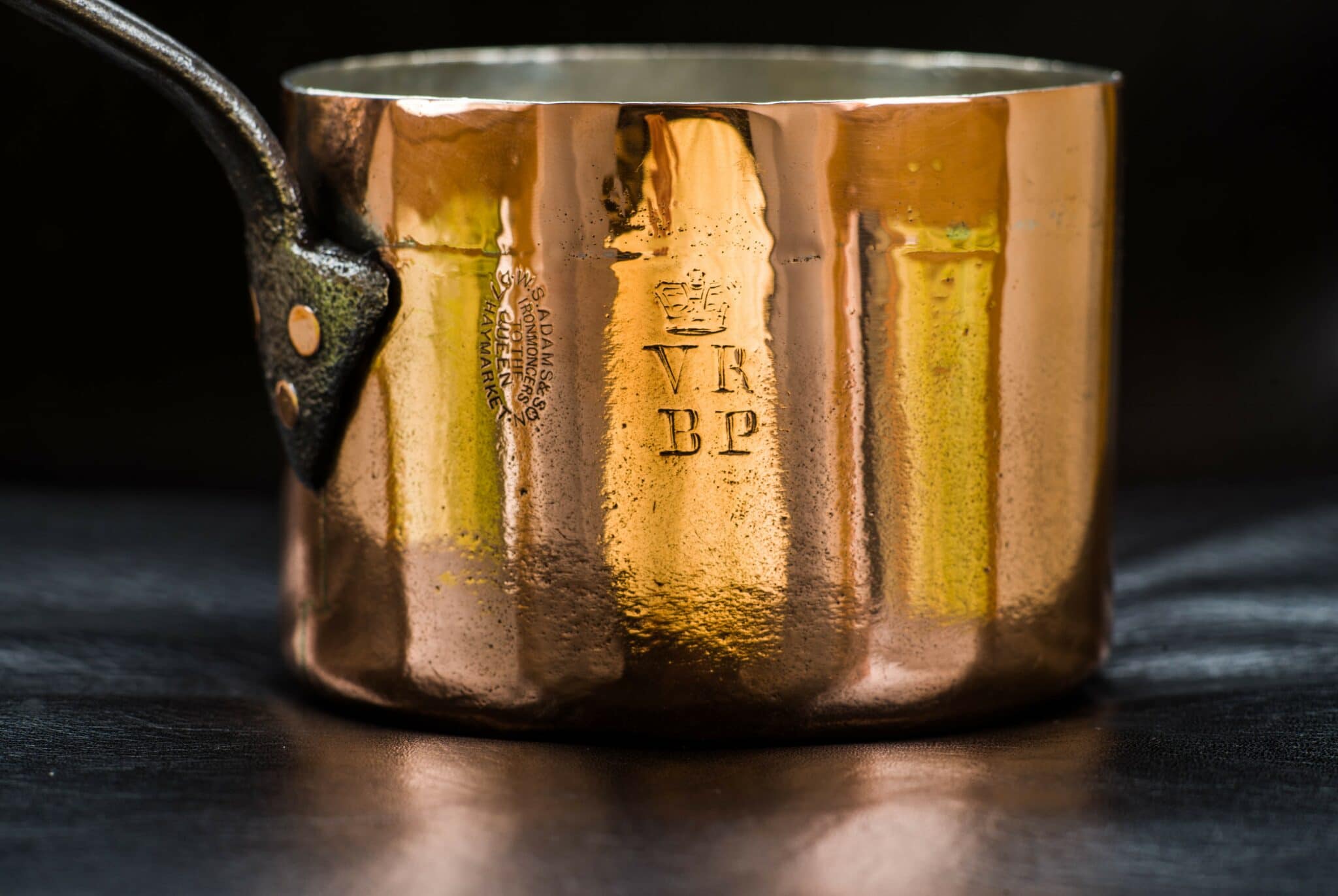

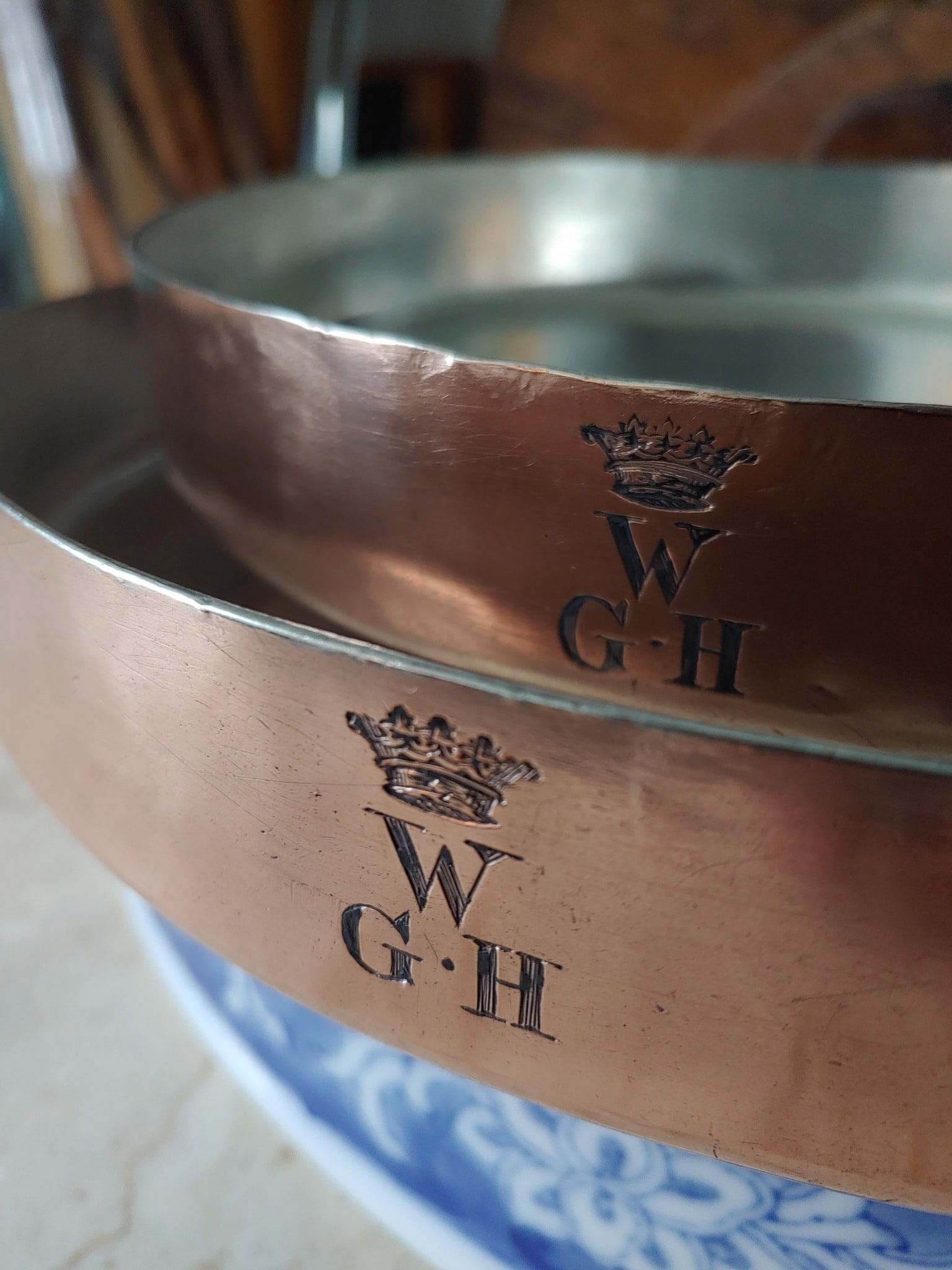
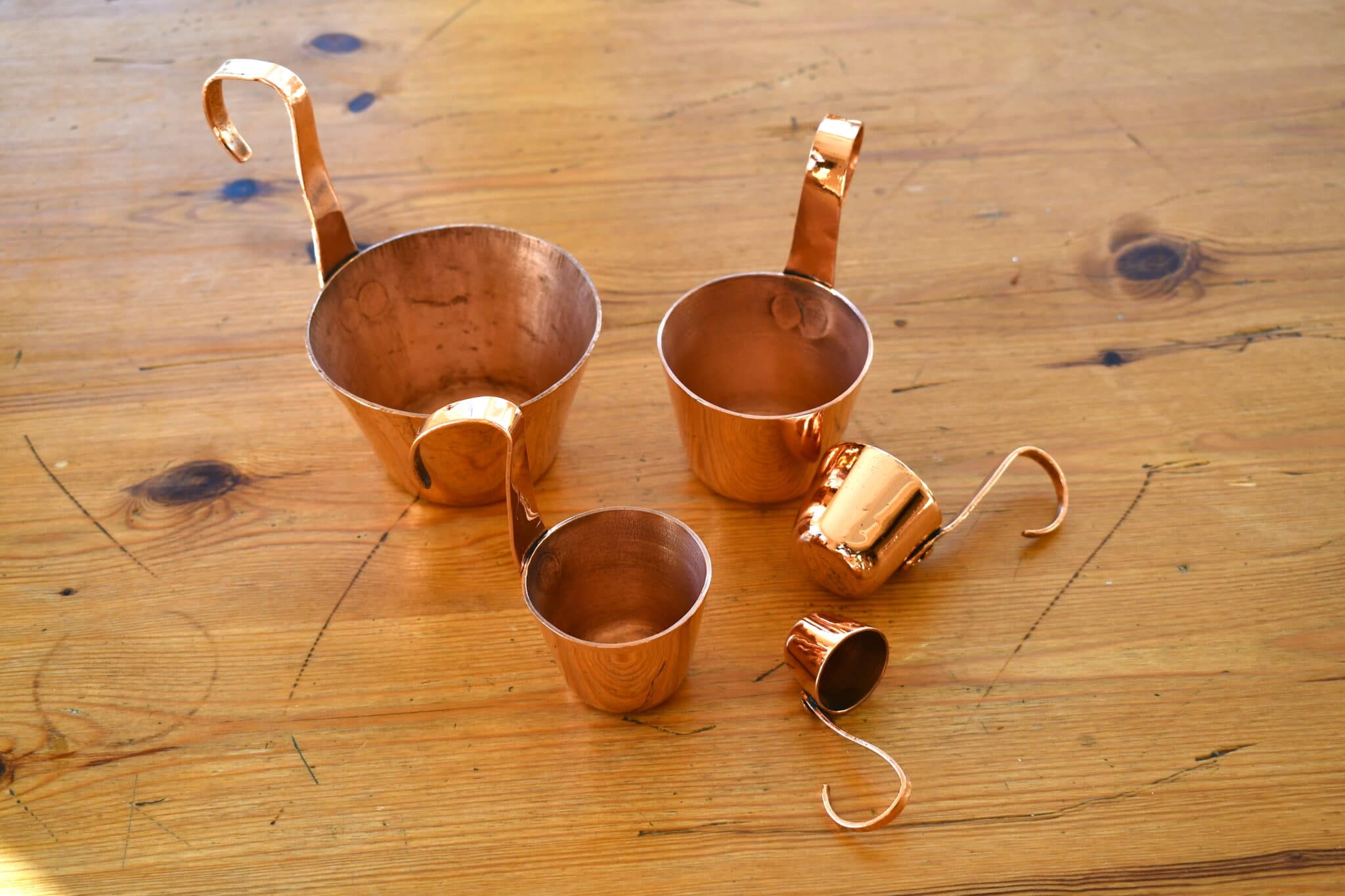
Hi Bryan, you discovered a beautiful pan with an unknown stamp. It´s a shame, one can’t even find a tiny trace on the Internet that leads to the manufacturer or retailer. Absolutely nothing! Frustrating.
Since I could neither see the first nor the last letter of the name in the stamp, I allowed myself to play with new letters and with omissions. Almost nothing was right. At least I was able to establish that there are both the names Barthèr and Barthère.
Eventually I found an old postcard showing a shop called E. Barthère in Bordeaux. Unfortunately the photo is so tiny that I can’t see what was being sold in this store. If the last letter could actually be deciphered as E instead of Z, we would be a little further. But that can only be decided by Bryan, who can see the original stamp.
Quincaillerie G. Malacrida & Cie, E. Barthère associé successeur, 1 cours Saint-Louis à Bordeaux. / s.n. – 1908
Hardware store
Quincaillerie = hardware, ironsmith, metal goods
Since I’ve now found a larger copy of the photo, I can also see metal goods in the shop window, which can be defined as pans, kettles, etc. The business reminds me a little of Dehillerin and Allez Freres, only much smaller.
https://archives.bordeaux-metropole.fr/ark:/75241/vta715e3fc580976a5e/dao/0#id:888543452?gallery=true&brightness=100.00&contrast=100.00¢er=1504.000,-984.000&zoom=6&rotation=0.000
Hi Martin, I think you’ve solved the mystery. I’m sending new photos to VFC of the stamp…the stamp on the left side of the handle it looks like there is the lower third of an “E”, while the stamp on the right side has faint traces of the top and bottom of an “E”. Thank you for your research!
I didn’t originally notice this on the Williams Sonoma pan, the rivet on the right retains its assumedly original tinning on the outside. This is the rivet that has the number “16” on the inside.
I have a Williams Sonoma saucepan with a diameter of 18cm. The three inner rivets are provided with digits that I have read so far as 18, matching the diameter of the pan. However, it could also be read as 16. It is very difficult to differentiate. 16mm would be roughly the diameter of each rivet.
Cheers to Martin! I was able to find some more information on Barthere in Bordeaux and I have updated the post! I still think the pan is 1930s-ish, likely under “P. Barthere”. Please take a look at the revised section and my sincere thanks again for your help!
Wonderful sleuthing everyone and lovely pans, Bryan!
Good teamwork. Thank you VFC! It is always challenging and exciting to find out more about a previously unknown manufacturer.
Whether Barthère had this pan made in its own workshop or whether it came from an unknown supplier and was then sold in Barthère’s shop cannot be said with certainty. But we know this combination of production and sale from certain periods of Dehilleirin, Gaillard and Allez-Freres.
France is organized centrally, politically and culturally. Everyone looks to Paris and orientates themselves on the capital. The entire rest of the country is perceived by the French as a province and is also called that. But as TJ France has already described on its website, at least two other regions besides Paris are important for the manufacture of copper items: Villedieu-les-Poêles in Normandy and Cantal in the Auvergne region. I suspect there are other not entirely unimportant “satellites” (like Barthère).
TJ already lists more than 150 manufacturers, but you can always find other, hitherto little-known craft businesses that have made very good copper goods. These workshops are spread all over France, but also over the neighboring countries (B, CH, D, I), especially since the border regions have cultural and linguistic similarities. I only recently came across Pianfetti Freres from Sallanches (Haute-Savoie) in the Auvergne-Rhône-Alpes region, a workshop that supplied hotels and restaurants with its professional pans.